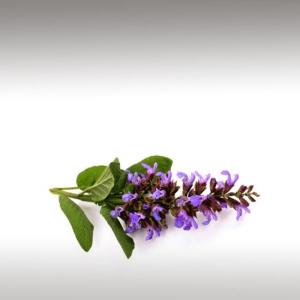
CLARY SAGE ESSENTIAL OIL (SALVIA SCLAREA) - ESSENTIAL OILS

BASE / GENERAL DATA
Information submited: April 9, 2015 Modified: March 7, 2018 By: OperaDreamhouse
Botanical Name: Salvia sclarea
Common Method of Extraction: Steam Distilled
Part Typically Used: Leaves and Flowers/Buds
Color: Light Golden Yellow
Consistency: Thin to Medium
Perfumery Note: Middle
Strength of Initial Aroma: Bright, earthy, herbaceous, with a subtle fruity note, sweet, nutty scent, almost a floral quality.
Salvia comes from a Latin word "Salvere" meaning "To heal or save". Clary comes from a Latin word "Clarus" meaning "Clear".
The Romans called it Sclarea, from claurus, or “Clear,” because they used it as an eyewash. The practice of German merchants of adding clary and elder flowers to Rhine wine to make it imitate a good Muscatel was so common that Germans still call the herb Muskateller Salbei and the English know it as Muscatel Sage.
Salvia Sclarea, Clary, or Clary Sage, is a biennial or short-lived herbaceous perennial in the genus Salvia. It is native to the northern Mediterranean, along with some areas in north Africa and Central Asia.
The plant has a lengthy history as a medicinal herb, and is currently grown for its essential oil.
Salvia Sclarea reaches 0,91 to 1,22 m in height, with thick square stems that are covered in hairs.
The flowers are lilac or pale blue, pink or white, in whorls on top of the stems, with the upper lip curled up. The leaves are broad oval or heart - shaped, in pairs, 6-9 inches long, covered with fine silver - white hairs, almost stalkless. It blooms from June to July.
The flowers and leaves are collected at the end of blooming when the level of volatile oil in the plant is at its highest. The cutting and bundling usually takes place during the afternoon at which time the level of oil is at its daily peak unless it is too hot and sunny, raining or foggy. Heat evaporates the oil and excess humidity lowers the yield.
Any woody stalks are removed prior to charging the still since they contain virtually no oil, and because the yield is quite low via steam distillation (0.15% to 0.4%), it is processed quickly to avoid the loss of precious oil by evaporation.
Freshly distilled Clary Sage essential oil is colourless to pale olive with a tenacious warm, balsamic, sweet - herbaceous aroma that has characteristic nutty, woody and tobacco - like nuances.
Chemical structure:
The chief components of Clary Sage essential oil are Sclareol, Alpha Terpineol, Geraniol, Linalyl Acetate, Linalool, Caryophyllene, Neryl Acetate and Germacrene-D.
Common Method of Extraction: Steam Distilled
Part Typically Used: Leaves and Flowers/Buds
Color: Light Golden Yellow
Consistency: Thin to Medium
Perfumery Note: Middle
Strength of Initial Aroma: Bright, earthy, herbaceous, with a subtle fruity note, sweet, nutty scent, almost a floral quality.
Salvia comes from a Latin word "Salvere" meaning "To heal or save". Clary comes from a Latin word "Clarus" meaning "Clear".
The Romans called it Sclarea, from claurus, or “Clear,” because they used it as an eyewash. The practice of German merchants of adding clary and elder flowers to Rhine wine to make it imitate a good Muscatel was so common that Germans still call the herb Muskateller Salbei and the English know it as Muscatel Sage.
Salvia Sclarea, Clary, or Clary Sage, is a biennial or short-lived herbaceous perennial in the genus Salvia. It is native to the northern Mediterranean, along with some areas in north Africa and Central Asia.
The plant has a lengthy history as a medicinal herb, and is currently grown for its essential oil.
Salvia Sclarea reaches 0,91 to 1,22 m in height, with thick square stems that are covered in hairs.
The flowers are lilac or pale blue, pink or white, in whorls on top of the stems, with the upper lip curled up. The leaves are broad oval or heart - shaped, in pairs, 6-9 inches long, covered with fine silver - white hairs, almost stalkless. It blooms from June to July.
The flowers and leaves are collected at the end of blooming when the level of volatile oil in the plant is at its highest. The cutting and bundling usually takes place during the afternoon at which time the level of oil is at its daily peak unless it is too hot and sunny, raining or foggy. Heat evaporates the oil and excess humidity lowers the yield.
Any woody stalks are removed prior to charging the still since they contain virtually no oil, and because the yield is quite low via steam distillation (0.15% to 0.4%), it is processed quickly to avoid the loss of precious oil by evaporation.
Freshly distilled Clary Sage essential oil is colourless to pale olive with a tenacious warm, balsamic, sweet - herbaceous aroma that has characteristic nutty, woody and tobacco - like nuances.
Chemical structure:
The chief components of Clary Sage essential oil are Sclareol, Alpha Terpineol, Geraniol, Linalyl Acetate, Linalool, Caryophyllene, Neryl Acetate and Germacrene-D.

SPIRITUAL PRACTISES DATA

MEDICINE / HEALTH DATA

BEAUTY / COSMETICS DATA

FOOD / COOKING DATA
COMMENTS
No comments.


